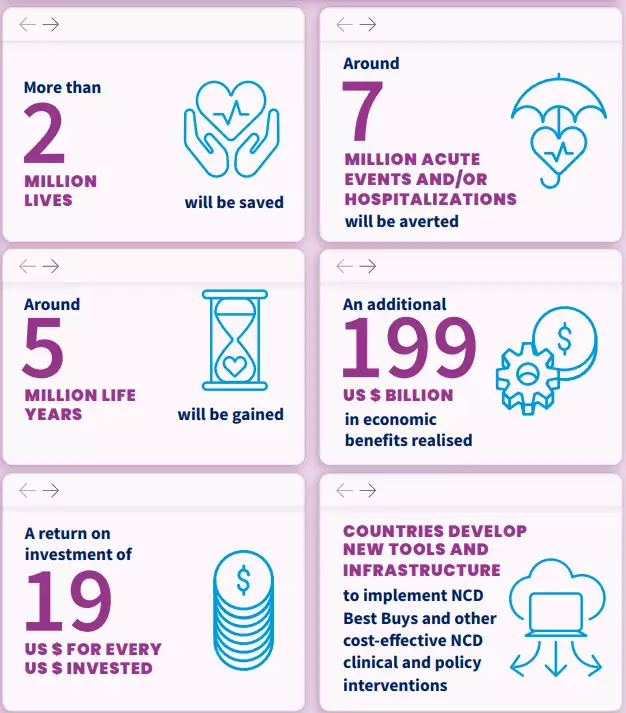Going digital for noncommunicable diseases, the World Health Organization (WHO) and International Telecommunication Union (ITU) have jointly released a report titled “Going digital for noncommunicable diseases: the case for action” on digital health interventions, outlining their potential to save lives and strengthen global healthcare systems, especially in addressing Non-Communicable Diseases (NCDs).
Key Highlights:
- Investment Potential: Investing $0.24 per patient annually in digital health tools like telemedicine, mobile messaging, and health chatbots can save 2 million lives and boost the global economy by $199 billion over the next decade.
- Impact on Healthcare: These interventions can prevent 7 million hospitalisations over 10 years, alleviating pressure on healthcare systems.
- Cost Breakdown:
- Global investment required: $9.8 billion over 10 years.
- Low-income countries: $0.12 per patient/year.
- Upper-middle-income countries: $0.16 per patient/year.
- High-income countries: $0.67 per patient/year.
- Non-Communicable Diseases (NCDs):
- NCDs include cardiovascular diseases, cancer, diabetes, and chronic respiratory conditions.
- NCDs account for 74% of global deaths annually.
- Managing these diseases requires continuous care and long-term health interventions.
About Digital Health Interventions (DHIs):
- Types of DHIs: Online programs, mobile applications, virtual reality, telehealth, telemedicine, wearable devices, online counseling, and AI-enabled applications powered by big data.
Benefits of Digital Health Interventions (DHIs):
- Health Outcomes:
- Save over 2 million lives globally from NCDs over the next decade.
- Avert 7 million acute events and hospitalisations.
- Economic Benefits:
- Contribute $199.2 billion to the global economy over the next decade.
- Return on investment (ROI): $19 for every $1 invested.
Examples of Successful Digital Health Interventions:
- Telemedicine:
- Improved blood pressure control in patients with hypertension.
- Helped regulate glycated haemoglobin (HbA1c) levels in Type 1 and Type 2 diabetes patients.
- Mobile Messaging and Chatbots: Enhanced successful tobacco cessation efforts.
- Case Studies:
- Senegal’s mRamadan Campaign: Leveraged mobile technology for NCD prevention and management.
- Zambia’s Telemedicine Initiatives: Successfully implemented under the Be He@lthy, Be Mobile programme by WHO and ITU.
Challenges in Integrating Digital Health Technologies:
- Infrastructure and Interoperability: Despite digital health strategies in over 60% of countries, infrastructure challenges persist.
- Call for Action: WHO urges governments to invest in digital public infrastructure to maximise the benefits of digital health interventions.
WHO’s Strategic Framework:
- Global Initiative on Digital Health: The report supports WHO’s Global Initiative on Digital Health and the Global Strategy on Digital Health 2020-2025.
India’s Digital Health Interventions:
- Ayushman Bharat Digital Mission: Aims to establish a national digital health ecosystem with the Ayushman Bharat Health Account (ABHA) number.
- e-Sanjeevani: The world’s largest documented telemedicine platform for primary healthcare.
- e-Hospital: A Hospital Management Information System (HMIS) to streamline internal workflows in hospitals.
- e-RAKTKOSH: A centralised blood bank management system for efficient blood donation and distribution.
Ref: Source
| UPSC IAS Preparation Resources | |
| Current Affairs Analysis | Topperspedia |
| GS Shots | Simply Explained |
| Daily Flash Cards | Daily Quiz |
Frequently Asked Question:
What is the primary focus of the WHO and ITU report on digital health interventions?
The report emphasizes the role of digital health tools in addressing noncommunicable diseases (NCDs) and saving lives globally.
How much investment is required per patient annually for digital health tools?
Investing $0.24 per patient annually in digital health tools can significantly improve healthcare outcomes and economic growth.
What are Non-Communicable Diseases (NCDs)?
NCDs are long-term diseases like cardiovascular issues, cancer, diabetes, and chronic respiratory conditions, causing 74% of global deaths annually.
What economic benefits can be achieved through digital health interventions?
Digital health tools could contribute $199.2 billion to the global economy over the next decade and provide a return of $19 for every $1 invested.
What successful digital health initiatives have been implemented globally?
Senegal’s mRamadan Campaign and Zambia’s Telemedicine Initiatives have effectively utilized mobile and telemedicine technologies for NCD management.




